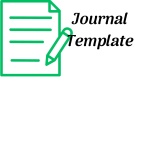Batik Liquid Waste Management in the Batik Center Area of Tasikmalaya
Abstract
Batik production in Indonesia is increasing from year to year. However, regarding environmental quality, it is feared that it will produce waste that pollutes the surrounding water bodies. This study aims to describe problems and solutions in improving the management of batik liquid waste in the city and district of Tasikmalaya (Cipedes and Sukaraja) using descriptive qualitative methods and the Miles and Huberman model. The results of the research using interview and observation methods show that most batik SMEs in these two areas have been unable to manage waste optimally. The problem arising from batik liquid waste is the contamination of residents' fish ponds, sewers, and bathtubs. Although there are three independent and communal WWTPs (Wastewater Treatment Plants) in Cipedes (MSME Agnessa, Deden, and riverbanks) as well as one independent WWTP in UMKM Sukapura "GJM," their utilization is still constrained by various natural and artificial factors. The role of the surrounding community is still low in understanding the existence and impact of batik waste around them.
Downloads
References
Dewi, R. S., Kasiamdari, R. S., Martani, E., & Purwestri, Y. A. (2019). Efficiency of Aspergillus sp. 3 to Reduce Chromium, Sulfide, Ammonia, Phenol, and Fat From Batik Wastewater. IOP Conference Series: Earth and Environmental Science, 308(1), 1–8. https://doi.org/10.1088/1755-1315/308/1/012003
Fajar, M., Mediani, A., & Finesa, Y. (2019). Analisis Peranan IPAL Dalam Stategi Penanganan Limbah Industri Batik di Kota Pekalongan. Pengembangan Wilayah Berkelanjutan Di Era Revolusi Industri 4.0, 84–90. Surakarta: Geografi Universitas Muhammadiyah Surakarta.
Fidiastuti, H. R., Lathifah, A. S., Amin, M., & Utomo, Y. (2020). Studies of Bacillus subtilis NAP1 to Degrade BOD, COD, TSS, and pH: The Indigenous Bacteria in Indonesia Batik Wastewater. Journal of Physics: Conference Series, 1511(1), 1–7. https://doi.org/10.1088/1742-6596/1511/1/012060
Fuji, R., Ahdhianto, E., & Perdana, R. (2020). Analysis of Chromium ( VI ) Concentration in the Area Around the Wastewater Treatment Plant at the Batik Factory. Journal of Xi’an University of Architecture & Technology, 12(6), 1703–1709.
Hafidh, R., Kartika, F., & Farahdiba, A. U. (2016). Keberlanjutan Instalasi Pengolahan Air Limbah Domestik (Ipal) Berbasis Masyarakat, Gunung Kidul, Yogyakarta. Jurnal Sains &Teknologi Lingkungan, 8(1), 46–55. https://doi.org/10.20885/jstl.vol8.iss1.art5
Hastutiningrum, S., & Purnawan, P. (2017). Pra-Rancangan Instalasi Pengolahan Air Limbah (Ipal) Industri Batik (Studi Kasus Batik Sembung, Sembungan Rt.31/Rw.14, Gulurejo, Lendah, Kulonprogo). Eksergi, 14(2), 52–62. https://doi.org/10.31315/e.v14i2.2148
Indrayani, L., & Triwiswara, M. (2018). Tingkat Efektivitas Pengolahan Limbah Cair Industri Batik Dengan Teknologi Lahan Basah Buatan. Dinamika Kerajinan Dan Batik: Majalah Ilmiah, 35(1), 53. https://doi.org/10.22322/dkb.v35i1.3795
Joko, T., Dangiran, H. L., Astorina, N., & Dewanti, Y. (2015). The Effectiveness of Plant Pistia Stratiotes Weight to Reduction of Heavy Metal Content Chromium (Cr) Waste at Batik Home Industry in Regency of Pekalongan. International Journal of Sciences: Basic and Applied Research, 24(2), 45–54. Retrieved from http://gssrr.org/index.php?journal=JournalOfBasicAndApplied
Kemenperin RI; BPS. (2016). Data IMKM Batik di Seluruh Indonesia. Jakarta.
Kurniawan, M. W., Purwanto, P., & Sudarno, S. (2014). Strategi Pengelolaan Air Limbah Sentra UMKM Batik Yang Berkelanjutan Di Kabupaten Sukoharjo. Jurnal Ilmu Lingkungan, 11(2), 62–72. https://doi.org/10.14710/jil.11.2.62-72
Menteri Lingkungan Hidup RI. Peraturan Menteri Lingkungan Hidup Nomor 03 Tahun 2010 Tentang Baku Mutu Air Limbah Bagi Kawasan Industri. , Pub. L. No. PermenLH Nomor 03 Tahun 2010, Menteri Negara Lingkungan Hidup 1 (2010).
Muchtasjar, B., Hadiyanto, H., & Izzati, M. (2019). Microbial Degradation of Batik Waste Water Treatment in Indonesia. IOP Conference Series: Earth and Environmental Science, 314(1), 1–5. https://doi.org/10.1088/1755-1315/314/1/012020
Natalina, N., & Firdaus, H. (2018). Penurunan Kadar Kromium Heksavalen (Cr6+) Dalam Limbah Batik Menggunakan Limbah Udang (Kitosan). Teknik, 38(2), 99–102. https://doi.org/10.14710/teknik.v38i2.13403
Noviar, I., Munir, E., & Nurtjahja, K. (2019). Preliminary Study of Local Bacteria Isolates in Decolorizing Liquid Waste from Boiling Process of Batik Industry. IOP Conference Series: Earth and Environmental Science, 305(1). https://doi.org/10.1088/1755-1315/305/1/012017
Oktaviani, N. (2018). Identifikasi Bakteri Pada Air Limbah Pencucian Pembuatan Batik di Pekalongan Selatan. Jurnal PENA, 32(02), 59–67.https://doi.org/10.1017/CBO9781107415324.004
Sugiyono. (2013). Metode Penelitian Kuantitatif, Kualitatif, dan R & D (19th ed.; Sugiyono, ed.). Bandung: Alfabeta.
Suharto. (2011). Limbah Kimia dalam Pencemaran Air dan udara (1st ed.; Oktaviani, ed.). Yogyakarta: Andi Offset.
Sunarya, Y., Anas, B., & Syarief, A. (2011). Pemetaan Desain Batik Priangan (Jawa Barat) Modern dalam Konteks Industri Kreatif di Bandung. Konferensi Internasional Budaya Sunda II : Revitalisasi Budaya Sunda : Peluang Dan Tantangan Dalam Dunia Global, (December), 2–12. Bandung: Yayasan Kebudayaan Rancage.
Wulandari, P. R. (2014). Perencanaan Pengolahan Air Limbah Sistem Terpusat (Studi Kasus di Perumahan PT. Pertamina Unit Pelayanan III Plaju - Sumatera Selatan. Jurnal Teknik Sipil Dan Lingkungan, 2(3), 499–509. Retrieved from https://ejournal.unsri.ac.id/index.php/jtsl/article/download/1336/pdf
Copyright (c) 2023 Vita Meylani, Frista Mutiara, Diana Hernawati

This work is licensed under a Creative Commons Attribution-NonCommercial 4.0 International License.
All rights, title and interest in the copyright to manuscript submitted, if accepted, are hereby transferred to Maximus : Journal of Biology and Life Sciences. This includes display of the accepted article in electronic form on the internet before and/or after print publication (if any). The authors must confirm that the manuscript contains no material that would violate the copyright or any other right of any other person. The authors reserve unto themselves the following rights the right to make copies for personal teaching use, and to reproduce reasonable quantities for personal use only; the right to reuse figures and tables in articles published in other books or journals (with bibliographic reference to Maximus : Journal of Biology and Life Sciences); any proprietary rights other than copyright, including the right to any patentable subject matter contained in the manuscript and the right to deny any subsequent commercial use.







